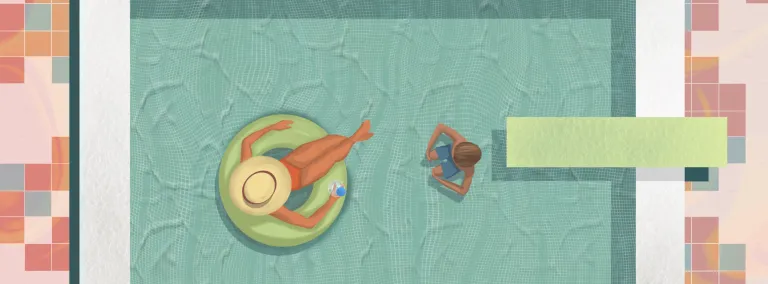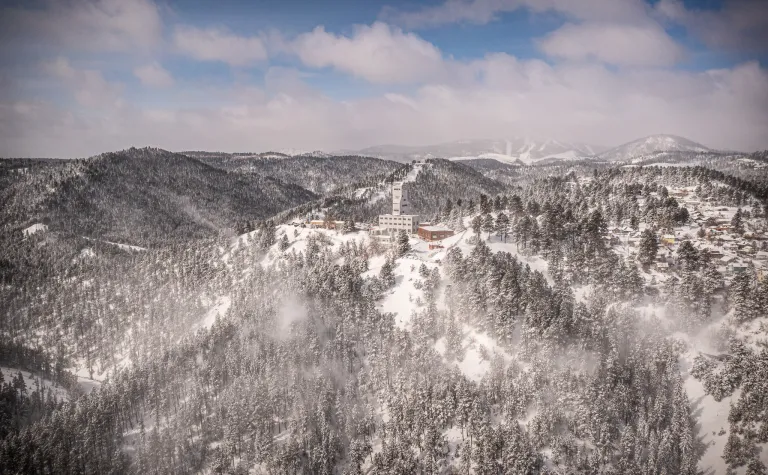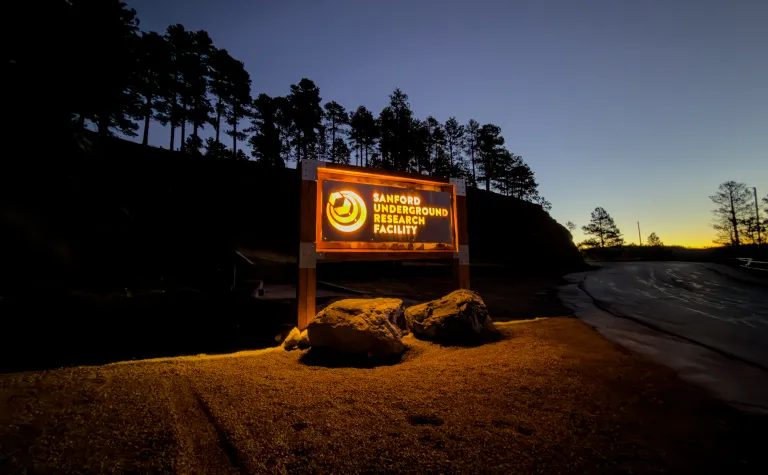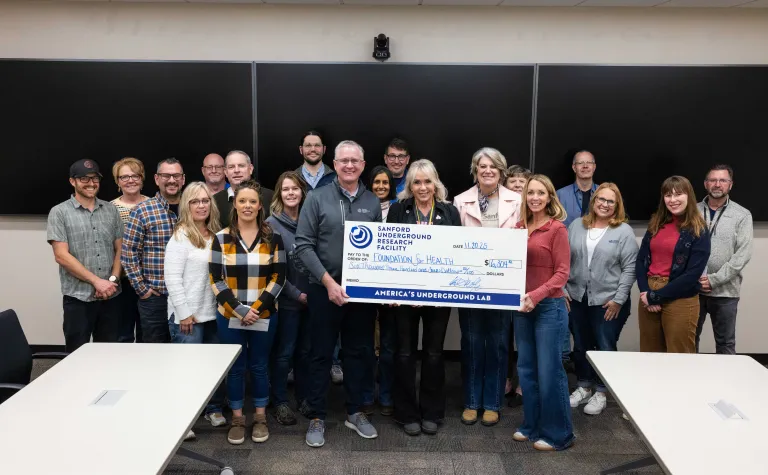The future of quantum might just be underground
Quantum sensors and quantum computers may benefit from a reduction in cosmic-ray muons offered in places like the Sanford Underground Research Facility (SURF) in Lead, SD.
Imagine a sunny summer afternoon floating on an inflatable mattress in a backyard pool. You have a nice beverage in hand and just as you are about to take a sip, one of your kids cannonballs off the diving board right next to you—the splash covers you in water and the waves topple your drink.
This scenario is somewhat like what a quantum bit might encounter when hit by the barrage of cosmic-ray muons that constantly rain down on Earth. Quantum bits, or qubits, are the powerhouses of quantum computers, (learn more about qubits in this article from Symmetry), and each qubit sits on a substrate that is somewhat like the surface of that serene swimming pool.
“As long as the swimming pool is calm, the bits will behave and operate normally. But if anything splashes into the pool, it will make a wave that spreads through the pool and disrupt the bits. Then you must reset them, and start all over again,” explains Steven Sekula, a professor of physics at Queen’s University and research group manager at SNOLAB, Canada’s deep underground research laboratory.
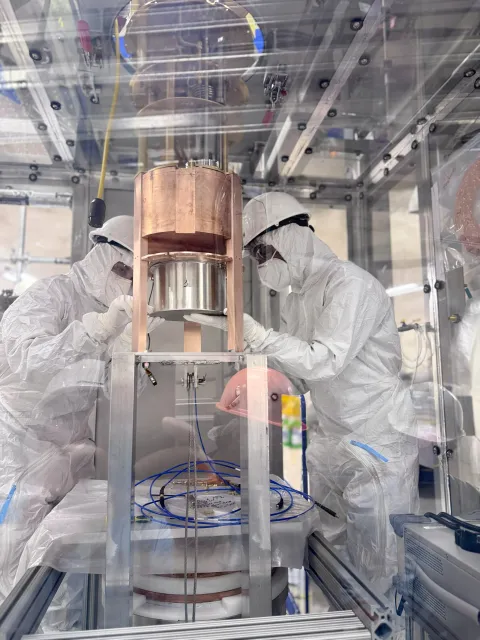
Ayesha Iqbal (left) and Yusuf Ahmed (right) in SNOLAB’s Cryogenic Underground Test Facility (CUTE) cleanroom, installing the test qubits into the CUTE dilution fridge.
Photo courtesy SNOLAB
Sekula says qubits housed inside a quantum computer on the surface of the planet might encounter this kind of cosmic ray interference every few seconds.
“Quantum calculations are fast, but if you want a quantum computer to be stable for more than just a few seconds, you really need to solve this problem. So, one of the ways to do that is go underground, get out of that radiation field at the surface of the Earth and stop the splashing from happening.”
SNOLAB is home to the Cryogenic Underground Test Facility or CUTE. The facility now includes three dilution refrigerators. These unique devices provide the supercooled state required for quantum systems to function. CUTE has been key in pioneering research in dark matter sensors. Sekula says it will soon be home to a new experiment to help determine if running a quantum computer deep underground provides real benefits.
“The experiment includes a custom-built set of qubits that were made by Chalmers University in Sweden,” Sekula said. “They were then tested on the surface at the University of Waterloo. We're going to take the same qubits and put them in the dilution refrigerator in CUTE underground at SNOLAB, and we're just going to see if the error rate goes down.”
The issue of cosmic ray interference in quantum computing is a hot topic; the biggest tech sector companies in the world are all vying for advantage in this sector. There are major efforts underway to reduce this interference including software-based quantum error correction techniques, lead shielding, and radiation-resistant qubits—all these things might limit the need to go deep underground.
“There is also a good chance that most of the benefit of shielding comes from digging a shallower hole in the ground that's maybe 200 or 300 feet deep,” Sekula said. “Going down 5000 to 7000 feet in a place like SURF or SNOLAB may be overkill. Or it may not be, the whole point of doing the science is that we won't know until we look.”
Quantum sensing—opening new frontiers of study
The simple idea that you can’t find something you don’t have the tools to see is the underlying premise for a second and separate realm of quantum research; developing high-end sensors that can detect rare and minuscule phenomena in physics. This could include everything from detecting low mass dark matter and gravitational waves to observing neutrino less double-beta decay, advancing particle astrophysics, and more.
TESSERACT is one of the examples that employs quantum sensing in the hunt for dark matter. The article “Small But Mighty: TESSERACT Joins the Hunt for Dark Matter,” provides details of its use of quantum technology. The experiment is planned to be installed inside dilution refrigerators underground at the QUP laboratory inside the Kamioka Observatory in Japan this year, and inside the Modane Underground Laboratory in France by 2029.
Maurice Garcia-Sciveres is a senior scientist at Lawrence Berkeley National Laboratory and a member of the TESSERACT collaboration. Garcia-Sciveres says the ability to detect low mass dark matter requires both an underground laboratory where cosmic-ray muons are filtered out and a dilution refrigerator to reduce the thermal energy that would otherwise drown out the low-mass dark matter signal.
“You are not in the business of quantum without a dilution refrigerator,” Garcia-Sciveres said. He explains that in super sensitive applications the energy thresholds are much smaller than the motion created by atoms excited by heat—so lowering the temperature to near absolute zero inside a dilution refrigerator—enables the detection of these very small interactions. “Fortunately, dilution refrigerators are commodity items today that you can just buy off the shelf,” he adds.
Jaret Heise, the director of science at SURF, says the facility is actively seeking funding to add a dilution refrigerator to a location on the 4850 Level at the Davis Campus. Heise says the addition of this key scientific instrument would keep SURF, and the State of South Dakota, competitive in the realm of cutting-edge quantum research.
“A new ultra-low temperature facility at SURF will bring scientific staff and support development of novel detectors to address questions in fundamental nuclear and particle physics, isolated underground from ionizing radiation detrimental to quantum systems,” Heise said. “No deep underground cryogenic facility currently exists in the U.S. SURF is actively building partnerships that will bolster a statewide quantum initiative and establish internationally competitive research resources in South Dakota.”
Keeping the United States competitive in cutting edge quantum research may also mean expanding the facility’s ability to contribute to the emerging science of gravitational waves. These waves, predicted by Albert Einstein in 1916, were directly detected for the first time almost a century later, in 2015, by the Laser Interferometer Gravitational-Wave Observatory, or LIGO, in Washington State.
As the development of quantum-based detector technologies accelerates, the physics community is looking to combine the benefits of a quiet underground environment and novel quantum sensors with increased sensitivities to rare events in searches for gravitational waves and low-mass dark matter.
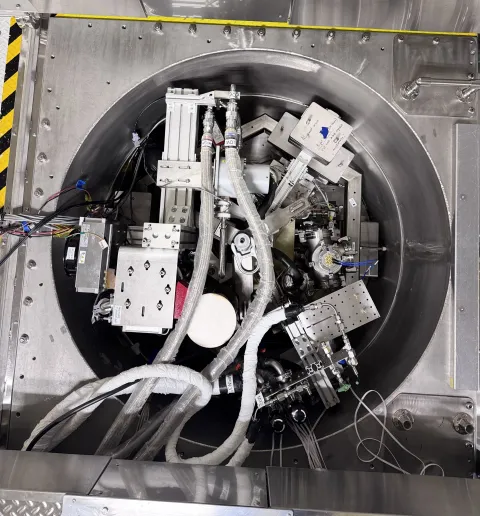
CUTE cryostat after the dilution fridge and qubits were installed in the drywell.
Photo courtesy SNOLAB
According to Heise: “Quantum computing and quantum sensors are two sides of the same coin. Qubits associated with quantum computers perform better when they are shielded from sources of radiation energy like cosmic-ray muons. On the other hand, upsets or ‘errors’ in quantum materials in a well isolated area could provide sensitivity to physics in domains we can’t otherwise reach today.”
Professor Oliver Buchmueller, from Imperial College London, spoke on the topic during a recent Deeper Talks lecture series titled, “Exploring the Universe with Quantum Technology: The New Frontier in Physics,” hosted by the Institute for Underground Science at SURF. The talk highlights the value underground research facilities, like SURF, can play in advancing this cutting-edge field of study.
Existing or planned experiments at underground labs like those at SNOLAB in Canada, Kamioka in Japan, Modane in France, Gran Sasso in Italy, and at other underground laboratories around the world are pursuing breakthroughs in both quantum computing and quantum sensing that could empower revolutions across many fields. America’s Underground Lab is looking to join this global research effort in the near future—doing so will allow SURF to remain a competitive collaborator in this area of quantum research.
